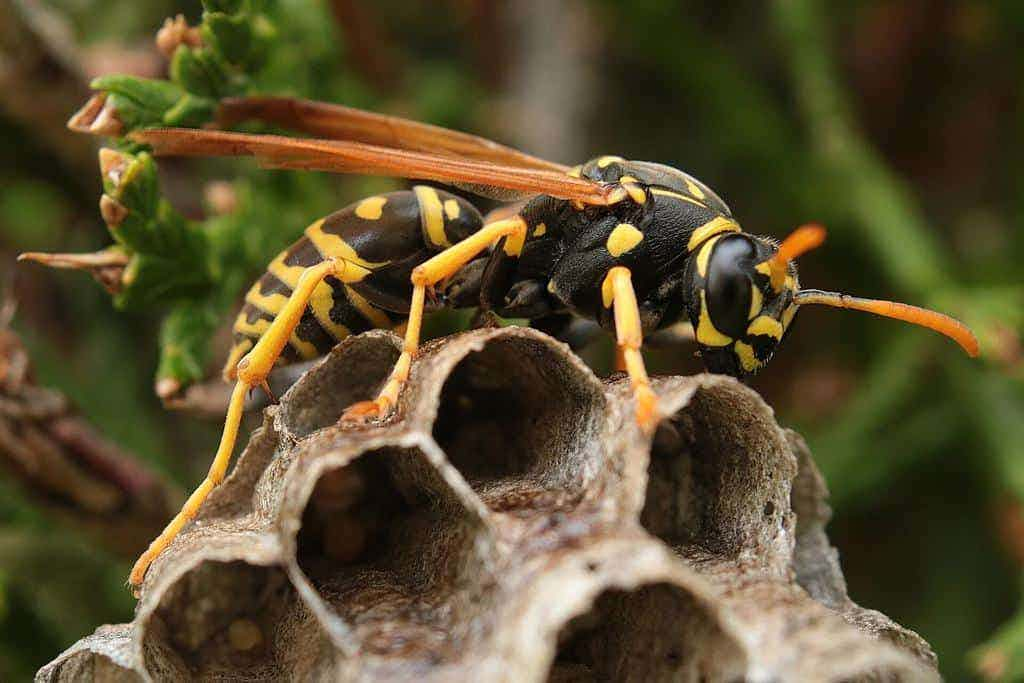Summertime is the perfect excuse to spend time in the garden, host barbecues, and bring out that jug of Pimm's and lemonade. Everyone loves to be outside, soaking up the sun, but sometimes we share the space with an irritating reality – wasps. Particularly more terrorising in more significant numbers, the presence of a wasp's nest can significantly dampen your blissful summer experience.
Wasps bury their nests around the lawn and in the garden, most commonly in semi-sheltered areas such as in wall cavities, under trees, even in the corners of your shed or garage. If left alone, these nests can grow to the size of a beach ball. If the nest is close to social areas, it is best to get rid of them to reduce the potential of nasty stings.
Identify the Nest
High numbers of wasps in and around your garden and home can be a sign there is a nest close by or, at least, there is something in the vicinity attracting the insects. Wasps nests are greyish-yellow in colour and look as though they have a paper-like texture. There are swirly patterns on the outside of the nest. Nests also appear in different sizes, depending on the maturity of the build. Even smaller nests, no bigger than a golf-ball, will become more problematic as the queen inside produces more eggs.
When to Remove a Nest
Wasp’s nests can be damaging to structures such as wooden sheds and other supporting structures, sometimes in your home. Wasps chew through wood and use it to build and reinforce their nests. If wasps eat through too much of the wood, it may cause the structure to give way. If a wasp attaches its nest to a wooden structure, such as a shed or a beam, it is worth removing it.
If someone in your household is allergic to wasps, a sting may be more harmful to them than to someone who does not have the allergy. In extreme cases, wasp stings have proven to be fatal. Removing a nest, in this case, protects those around you and prevents painful stings.
How to Get Rid of Wasp Nests
Experts emphasise that you should take great caution when removing a nest, to prevent a wasp stinging you. Contact a professional exterminator to remove a nest if necessary. Professionals have the correct protective equipment and experience. Unfortunately, many exterminators will kill the wasps using insecticide. It can take a few days for the wasps to die.
To avoid killing the wasps, you can also move the nest. Professionals advise against a DIY job, but should it be necessary there are steps you can take to ensure you do so safely.
- Make sure you are not allergic. Under no circumstances should you try to remove a nest if you are allergic to wasp stings.
- You must cover your entire body, including your face.
- Keep children and pets inside to avoid getting them stung.
- Use a plastic container, large enough to contain the entire nest. Make sure the container has a lid.
- Approach the wasp's nest at night, slowly and quietly. This is when the wasps are calmest as they are asleep.
- Place the container over the wasp nest.
- Using the lid of the container, sever the nest from its point of attachment.
- Place the lid over the container and move the nest to a more desired area.
- Leave it for an hour, then remove the lid. The wasps will now return to the nest in its new location.
There are organisations that provide advice on wasp sting allergies. There are traces of the allergy medical professionals can identify through blood tests. It is, however, difficult to tell whether you are allergic without getting stung in the first place. Symptoms include severe swelling, difficulty breathing and dizziness.
We spoke to Paul Blackhurst from Rentokil, who told Age Times: “Alongside their painful stings, wasps are notorious for building their nests in places in close proximity to people, including in building cavities and the eaves of houses, but they can also go unnoticed in attics and lofts.
"New queen wasps will emerge from their wintering sites and start to build new nests in the spring. It is advisable to treat a nest earlier in the year before numbers increase and the wasps become more aggressive, increasing the threat of being stung while dealing with these pests.
"Engaging with a local pest company is your most effective and safest route to the removal of a wasp nest, but there are some DIY products such as traps and sprays that can also help."
Wasps are Important
One cannot ignore that wasps are a vital part of your garden’s ecosystem, despite them annoying us. Wasps are efficient pest controllers, helping to manage pests that may damage your garden such as caterpillars. They are also great partners in helping to keep other pesky house invaders at bay like houseflies and spiders.
Additionally, wasps are essential for pollination. Nectar from flowers is an adult wasp's main diet. A wasp’s sweet tooth also means sugary beverages and foods containing sugar will attract them. It can be impossible to enjoy outdoor meals if a wasp nest is around!
Still, wasps are vital to maintaining a healthy and happy garden. Therefore, it is best to deal with them as humanely as possible and avoid destroying the nests or killing the wasps.
Blackhurst added: “You may be surprised to learn that wasps can also be highly beneficial to the ecosystem, especially when they are feeding their young grubs protein. They obtain this protein from consuming pest insects from the garden, and the grubs in turn reward the adults with a sugary secretion (essentially faeces).
"It is when the grub-to-adult ratio drops that issues can arise, as the adult wasps still crave their carb fix but may not get enough from their offspring. Typically this imbalance occurs around the end of July, which is when wasps can start becoming particularly annoying and persistent around items such as ice creams and sugary drinks.”
Leaving Wasp Nests Alone
Many people are happy to leave wasp’s nests alone, mainly for the reasons mentioned earlier. Wasp’s generally are not interested in attacking humans. Most stings happen simply by people being in the wrong place at the wrong time or because the wasp feels threatened. There are a few things to consider when deciding to keep or remove the nest.
Should you wish to have the nest remain in the vicinity of your home, make sure that you cover food and clean away crockery quickly after meals. If possible, cover drinks, either using coasters or anything that will cover the rim of the glass. Avoid drinking beverages out of bottles or cans as this may lead to unknowingly swallowing a wasp.
If your garden has a fruit tree, make sure overripe fruit does not lie around. Wasps enjoy the fruit, and the sweet scent is a natural attraction for them. You should cover any composting facilities, such as food bins, tightly, and keep them away from the home.
If you are hosting a garden party, and have a guest who is allergic, it is best to let them know about the wasps before they arrive at your property. They will have the right items to deal with an allergic reaction. You can leave something sweet close to the nest, such as a bowl of sugar water. The sweetness distracts the wasps, and they will not bother you and your party.
Preventing Wasps from Building a Nest
In most cases, it is easy to prevent wasps ever building their nests in the first place. Keep an eye out for nests in the spring. It is then that the queen inhabits a space and where the colony of wasps will return to. Setting up wasp traps are also a popular solution to preventing wasps building their nests. You can buy these from DIY shops. Maintaining buildings and sealing cracks in walls are effective methods of prevention.
Another, slightly more novel, method of nest prevention is to trick the wasps. As a territorial insect, wasps are highly unlikely to build a nest in a location they think otherwise occupied. Simply placing a wasp-nest-look-alike, brown, paper bag in trees or areas that could be at risk deters wasps from that area.
When removing a wasp's nest, it is safer to call a professional to deal with it for you. Experts will do the job correctly and ensure the wasps do not return. It is quite possible to live with wasps in your garden. They can also be incredibly harmful in which case it is best to have them removed or killed if necessary.








